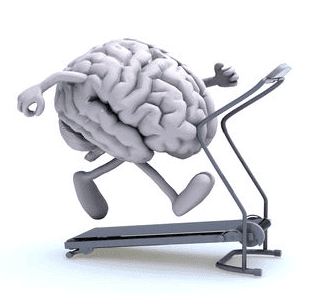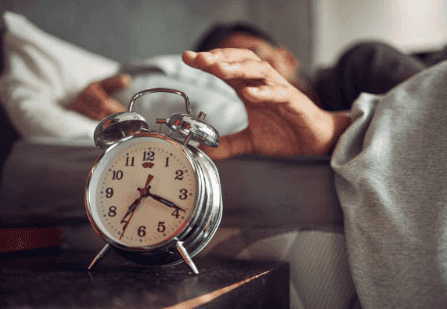Working In: Exercise's Role in Mental Health

Exercise has the unique ability to elicit adaptations in both the body and mind. In the world of superfoods, fountains of youth and the like, are we overlooking the unmatched, comprehensive health benefits of regular physical activity? In this article, I will focus on the positive mental effects of exercise. The commonly reported mental disease states, depression and anxiety, will be the focus. This article is not intended to diagnose or treat any conditions.
Anxiety
According to the National Institute of Health (NIH), generalized anxiety disorder is characterized as "displaying excessive anxiety or worry, most days for at least 6 months, about a number of things such as personal health, work, social interactions, and everyday routine life circumstances." The Generalized Anxiety Disorder 7-Item Scale (GAD-7), a subjective questionnaire, is a commonly used diagnostic tool. Questionnaire items include inability to relax, worrying, restlessness, irritability and other commonly reported symptoms of generalized anxiety disorder.
Depression
According to the NIH, depression is one of the most common mental disorders in the U.S. A multifaceted disorder, genetic, biological, environmental and other factors likely contribute to the wide variety of symptoms. Understood as a "mood disorder," depression can affect how you feel, think and act. Diagnosis is made following a minimum of two weeks with depressive symptoms. The Patient Health Questionnaire-9 (PHQ-9) is commonly used to diagnose. Loss of interest, increased fatigue, and hopelessness are among the many potential manifesting symptoms of depression.
Prevalence of Anxiety & Depression:

According to the World Health Organization's (WHO) report, “Depression and Other Common Mental Disorders: Global Health Estimates,” 4.4% of the global population is currently living with depression (322 million people) making depression the leading cause of disability worldwide. Depression is believed to be a multifaceted disorder including social, psychological and biological factors. (1) Depression is a highly complex, yet enormously important public health issue. Depression is predicted to be the second highest global burden of disease measured by number of years lost due to poor health, following a recent 20% prevalence increase. Depression rates were significantly higher in women, countries with a medium human development index and with the use of self-reporting instruments. (2)
The origin or onset of depressive symptoms is also complex. Severe "stress triggers" are hypothesized to contribute to depression by altering the brain's function. Early life stress may be predictive of one's lifetime vulnerability or resistance to stressful events. (3) Sui et al. reported that "major depressive disorder (MDD) in children and adolescents is strongly associated with recurrent depression in adulthood; other mental disorders; and increased risk for suicidal ideation, attempts, and completion." (4) Among children whom are diagnosed with major depressive disorder (∼8%), "functional impairments in their performance at school or work, natural development, and interactions with their families and peers are typically seen." Screening for MDD is generally recommended between the ages of 12-18, with insufficient data to suggest efficacy in children ≤11 years of age. Additionally, genetic factors appear to heighten one's susceptibility to MDD and suicidal ideation (SI). Taylor et al. findings support that "an adequate dose of physical activity diminishes risk of MDD and SI imposed by a genetic predisposition." (5)
As diagnosis and onset/origin of depression can be a complex area, therupatic avenues can also be relatively complex. When turning to self-care therapeutic options, stress management & adaptation techniques are a low hanging fruit to ensure continual, personalized practice. As we will discuss in this article, research suggests that exercise can help manage anxiety and depression, but it is important to understand that exercise is an additional tool and not a replacement for other forms of care that may be needed.
Stress: Adaptation vs. Wear & Tear

Bruce McEwen, a pioneer in stress physiology research, coined the term "allostatic load." Investigating the direct impact of various stressors on proper brain function, McEwen mentions that stress and trauma appear to "mediate physiological and behavioral responses." Strong emotions, particularly fear, appear to be the main driver(s) of these responses. McEwen further reinforces this belief, stating "stress is known to precipitate and exacerbate mood disorders including atrophy, hyperactivity and structural changes." (9)
McEwen's work details the multiple mechanisms responsible for positive stress adaptation. This adaptation is referred to as "allostasis" or "stability through change." Allostatic load is identified as the frequent, chronic or overstimulation of the allostatic systems. In normal circumstances, the adaptive systems effectively react to cope with stressors and "turn off" afterward. The trouble arises when allostatic load exceeds one's ability to adapt or overcome stressful events...known as the "price of adaptation." (12)
Types of allostatic load include:
(1) Frequent activation
(2) Failure to "shut off" after stressor
(3) Inadequate response/elevated activity of counter-regulations post stress
The key concept of allostatic load can be applied to various stressors, with an awareness of the dose dependent effects. Rather than stress avoidance, it is important to note that "stress promotes adaptation, but prolonged stress leads over time to wear-and-tear on the body." The key balance is between short-term stress eliciting adaptation versus chronic stress creating long-term damage. Numerous health detriments are a results of exceeding allostatic load and are seen in major depressive illness and chronic anxiety disorders. (10) Therefore, allostatic load, when incorporated as part of a comprehensive assessment may add additional insight into overall health. (11)
Beneficial self-care aspects of exercise:


Runners only "high"?
The "runner's high" is something most of you have heard of and some have experienced. What exactly is happening that results in this exercised-induced natural high? The commonly held belief of endogenous endorphin release has since been further investigated, uncovering the role of an additional system at play. The "runner's high" which may be explained in general terms as a combination of heightened mood, general relaxation and suppressed levels of pain, is largely due to the body's endocannabinoid system (ECS). The euphoric and analgesic effects largely depend on intact cannabinoid receptor 1 (CB1) receptors as well as peripheral CB1 and CB2 receptors. (13)
Aligning with McEwen's findings that strong emotions and stress "precipitate and exacerbate mood disorders," a bidirectional relationship between the ECS and anxiety and fear is becoming more apparent. The ECS possesses a "unique regulatory capacity for maintaining emotional homeostasis." In addition to the ECS's regulatory capacity, it has also been suggested that a properly functioning ECS serves as a "regulatory buffer system for emotional responses." (14) How then do you utilize this innate system to your advantage?
Exercise and the Endocannabinoid System (ECS):
Dr. Cecilia J Hillard, PhD is the director of the neuroscience research center at the medical college of Wisconsin. I had the opportunity to hear Dr. Hillard speak at the annual ACSM conference in Orlando, Florida in 2019. The topic of Dr. Hillard's presentation was on the effects of exercise on the ednocannabinoid system (ECS). If interested in a detailed breakdown of the ECS, it can be found in my previously article here.
The overarching theme of Dr. Hillard's presentation was various ways to activate the body's endogenous cannabinoid receptors. The most innate, proven method to do this is through.... exercise! Below is a breakdown of the ECS role taken directly from the presentation slide.

Brief overview:
The ECS acts on two cannabinoid receptors within the human body, CB1 and CB2. These receptors are termed G protein-coupled receptors (GPCRs). Varying in their location, CB1 receptors are abundant within the CNS (also the liver and adipose) while CB2 are primarily abundant within the immune system and brain microglia.
Key Takeaways:
- Exercise increases ECS, via enhanced ligand concentrations and increased CB1R density in multiple brain regions.
- There appears to be a down-regulatory effect on the ECS with chronic exercise.

- The ECS contributes to exercise-induced effects on pain perception and anxiety; and the rewarding effects of exercise

Dose Dependent: Finding your ideal routine
Remembering the FITT principles:
(F: Frequency, I: Intensity, T: Time, T: Type)
In my previous article "The Best Fitness Program: The One You Keep Doing" (visit here) I discussed the importance of exercise adherence and how to prioritize the big ticket items without getting lost in the weeds. When structuring an exercise routine while prioritizing the mental benefits, there are two areas worth giving a bit more attention to....F: Frequency & T: Type.
F: Frequency
Lynette et al. investigated the positive mood effects of exercise, independent of fitness gains. Results suggest that one should focus on frequency of exercise rather than duration or intensity. This likely has a very logical explanation, that being a more frequent natural "feel good" throughout the week compared to a less frequent, supposing a minimal, but not excessive, threshold is met. (6) In addition to the acute benefits of exercise, we can also refer back to the subjective short & long term benefits mentioned above.
T: Type
We again find support that choosing a form of exercise you prefer is the best course of action. Doyne et al. show that when comparing running (aerobic) to weight lifting (anaerobic) for treatment of depression, both conditions showed significant reduction when compared to control (no exercise). Furthermore, Mertinsen et al. compared aerobic to anaerobic in treatment of clinical depression. The results indicate that the antidepressive benefits of exercise occurred in both types of exercise, showing results to be independent of achieving an aerobic effect. (7,8)
An increase in aerobic fitness may not be the primary concern when pursing an anti depressive benefit of exercise. By choosing your preferred method of exercise you are both more likely to continue and receive the same benefit as you would have with a program you felt compelled to do. The majority of the benefits you will find are from consistent, enjoyable forms of physical activity and this is further shown among bipolar depressive patients who ranked exercise to be the most important element in comprehensive treatment programs. (16)
Summary
When accessing the right course of action for your personal self-care program, it is important to remember that all adaptations involve trade-offs, and the dose (frequency) and type will be highly individualized. Because of this, I encourage you not to strive for a "standard" or preconceived optimal routine but rather be aware of how you are feeling. I understand this can be difficult for some, and likely even more so in individual's with a susceptibility to mood disorder symptoms. However, by implementing this strategy you may be able to avoid the pressure of adhering to an unnecessary standard. Lieberman et al. sum this concept up nicely stating "humans evolved to be active for play or necessity, efforts to promote exercise will require altering environments in ways that nudge or even compel people to be active and to make exercise fun." Ultimately, adopting this mentality will lead to greater adherence which will enhance your desired results. (19)
Exercise as Treatment:

When looking at the big picture of exercise's role in a comprehensive health program, it is important not to overlook some of the most basic mental health questions. One question that may come to mind is whether an individual experiencing depressive symptoms is choosing not to exercise or if the lack of exercise is compounding the level of depression. The answer likely lies somewhere in the middle, varying from individual to individual.
Decreased fitness levels, indicated by a reduced physical work capacity (PWC), were found in patients with anxiety and depression. (16,18) A reduced work capacity is what we may commonly refer to as being "out of shape." So again, the chicken or the egg...would getting in shape improve depressive symptoms or are the depressive symptoms holding one back from exercising? When diving a bit more into the reduced PWC, an interesting finding is that those same individuals have normal pulmonary function. This would suggest that the reduced PWC is in fact caused by lack of physical activity. The main objective then seems to be overcoming the initial hurdle leading to inactivity to reap the benefits of appropriate levels of physical activity. (16)
An initial education period may be essential to overcome the first hurdle to incorporate a comprehensive health program. Often times it is the preconceived notions or beliefs we hold that keep us from beginning, continuing or changing. Feeling limited or obligated to adhere to a strict, particular form of physical activity can be a strong reason for one choosing not to participate. By overcoming this repeatedly reported limiting factor, we can then focus on the previously mentioned FITT principles that apply.
When applying the FITT princinples, we are ultimately striving toward increased likelihood of adherence. This is because the impediment to most health outcomes is lack of adherence, not incorrect exercise selection. This rings even more true when assessing exercise inclusive treatment plans for those suffering from mood disorders. Voderholser et al. mention that "compliance rates are rather low due to reduced energy and lack of motivation" and it is not uncommon to see "overstrain when participating in a training program." The necessity for individualized, patient preferred methods of exercise not only helps address the initial hurdle of decreased drive to exercise but allows proper attention to gradual increased exposure when beginning an exercise plan. (18)
An additional aspect to consider is appropriate short and long term goal setting. Following a tailored educational period, goals may provide even greater motivation and clarity moving forward. Gordon et al. results show "resistance exercise training significantly reduced depressive symptoms among adults regardless of health status, total prescribed volume of RET, or significant improvements in strength." (20) By clearly defining one's goals, you can more effectively navigate and accurately assess progress without getting caught up in commonly sought after areas of improvement. A more nuanced, personalized assessment, implementation and ultimately review is likely better suited for mental/cognitive goals.
By starting with the end goal in mind, you allow for various strategies, preferences and timelines to be implemented. A skilled trainer can ensure these defined goals get met and allow for flexibility along the way. By understanding some of the current limitations, both cognitively and physically, a trainer can assess the best course of action. An ongoing dialogue is essential to appropriate variation within an exercise inclusive treatment plan. Outside the scope of a fitness trainer, you may be taking part in addition forms of therapy. Exercise and other forms of therapy should not be thought of as competitors for greater benefits, rather tools of compounding interest. Schuch et al. reports that among those with MDD, exercise compared to psychological treatments showed no significant effects. However, both individually showed significant positive effects, further supporting that exercise is a viable adjunct treatment to other forms of therapy. (21)
Taking a step back:

So what...now you have this information, some general and some very specific. What does this mean to you? How do you put this into practice? What do you even put into practice?
The big takeaway is that exercise, regardless of your preferred method, improves mental health. The mechanism, reasoning, specifics...those aren't necessarily important. Whether you prefer running, resistance training, a sport... you have those tools at your disposal and the ability to interchange as desired. A mood boost, getting through a rut, supplementing other forms of care....the ability of exercise to elevate your mood, improve your day and, if used appropriately and consistently, your life is perhaps the most beneficial aspect of physical activity.
Action Items:
- Exercise: Your choice, tailored to your interests & lifestyle.
- Daily "meditation": Periods of disconnecting, slowing down and/or taking a bit of time to yourself. This doesn't need to be elaborate or over the top, simply a time to slow the pace of the day.
- Breath Work (,,Here): There are numerous breathing practices & protocols, but a good starting point is controlled, slow breathing (preferably nasal breathing).
- Take a step back: Before you add exercise, mediation, breath work, or any personal practice...try eliminating. Take a 1/2 day, full day or however much time needed to disconnect from stress inducing aspects of life. Being run down may exacerbate the downward mental spiral and lead to increased anxiety and depressive symptoms.
Consider supporting a great cause:
BREATHE FOR TEENS PROGRAM
SUPPORT NOVEL STRESS-REDUCTION RESEARCH FOR ADOLESCENTS
-> https://www.hhp-foundation.org/breathe-for-teens <-
References:
- Friedrich, M.J.Depression Is the Leading Cause of Disability Around the WorldJAMA317, no. 15 (April 2017): 1517.
- Lim, Grace Y., Wilson W. Tam, Yanxia Lu, Cyrus S. Ho, Melvyn W. Zhang, and Roger C. Ho.Prevalence of Depression in the Community from 30 Countries between 1994 and 2014Scientific Reports8, no. 1 (February 2018).
- Nestler, Eric J. Epigenetic Mechanisms of Depression JAMA Psychiatry 71, no. 4 (April 2014): 454.
- Albert L. Siu.Screening for Depression in Children and Adolescents: U.S. Preventive Services Task Force Recommendation StatementAnnals of Internal Medicine164, no. 5 (February 2016): 360.
- A genetic risk factor for major depression and suicidal ideation is mitigated by physical activity Author links open overlay panel Marcus K.Taylor Shiloh E.BeckerleyaNicole E.Hennigera Lisa M.Hernández Gerald E.Larson Douglas A.Grangercd
- The Benefits of Exercise for the Clinically Depressed Lynette L. Craft, Ph.D. and Frank M. Perna, Ed.D., Ph.D.
- Doyne EJ, Ossip-Klein DJ, and Bowman ED. et al.Running versus weight lifting in the treatment of depression.J Consult Clin Psychol. 1987 55:748–754.
- Martinsen EW, Hoffart A, Solberg O. Comparing aerobic and nonaerobic forms of exercise in the treatment of clinical depression: a randomized trial.Compr Psychiatry
- McEwen BS. Glucocorticoids, depression, and mood disorders: structural remodeling in the brain. Metabolism. 2005 May;54(5 Suppl 1):20-3.
- McEwen BS. Protection and damage from acute and chronic stress: allostasis and allostatic overload and relevance to the pathophysiology of psychiatric disorders. Ann N Y Acad Sci. 2004 Dec;1032:1-7.
- McEwen BS. Stress, adaptation, and disease. Allostasis and allostatic load. Ann N Y Acad Sci. 1998 May 1;840:33-44.
- Seeman, Teresa & Singer, Burton & Rowe, John & Horwitz, Ralph & Mcewen, Bruce. (1997). Price of Adaptation—Allostatic Load and Its Health Consequences: MacArthur Studies of Successful Aging. Archives of internal medicine. 157. 2259-68.
- Fuss J, Steinle J, Bindila L, Auer MK, Kirchherr H, Lutz B, Gass P. A runner's high depends on cannabinoid receptors in mice. Proc Natl Acad Sci U S A. 2015 Oct 20;112(42):13105-8.
- Ruehle S, Rey AA, Remmers F, Lutz B. The endocannabinoid system in anxiety, fear memory and habituation. J Psychopharmacol. 2012 Jan;26(1):23-39.
- Martinsen EW. Benefits of exercise for the treatment of depression. Sports Med. 1990 Jun;9(6):380-9.
- Martinsen EW, Strand J, Paulsson G, Kaggestad J. Physical fitness level in patients with anxiety and depressive disorders. Int J Sports Med. 1989 Feb;10(1):58-61.
- Lynette L. Craft, Frank M. Perna Prim Care Companion J Clin Psychiatry. 2004; 6(3): 104–111.
- Voderholzer U, Dersch R, Dickhut HH, Herter A, Freyer T, Berger M. Physical fitness in depressive patients and impact of illness course and disability. J Affect Disord. 2011 Jan;128(1-2):160-4.
- Lieberman, Daniel E. PhD Is Exercise Really Medicine? An Evolutionary Perspective, Current Sports Medicine Reports: July/August 2015 - Volume 14 - Issue 4 - p 313-319
- Gordon BR, McDowell CP, Hallgren M, Meyer JD, Lyons M, Herring MP. Association of Efficacy of Resistance Exercise Training With Depressive Symptoms: Meta-analysis and Meta-regression Analysis of Randomized Clinical Trials. JAMA Psychiatry. 2018 Jun 1;75(6):566-576.
- Schuch FB, Vancampfort D, Richards J, Rosenbaum S, Ward PB, Stubbs B. Exercise as a treatment for depression: A meta-analysis adjusting for publication bias. J Psychiatr Res. 2016 Jun;77:42-51.
- Kvam, Siri, Catrine Lykkedrang Kleppe, Inger Hilde Nordhus, and Anders Hovland.Exercise as a treatment for depression: A meta-analysisJournal of Affective Disorders202 (September 2016): 67–86.



